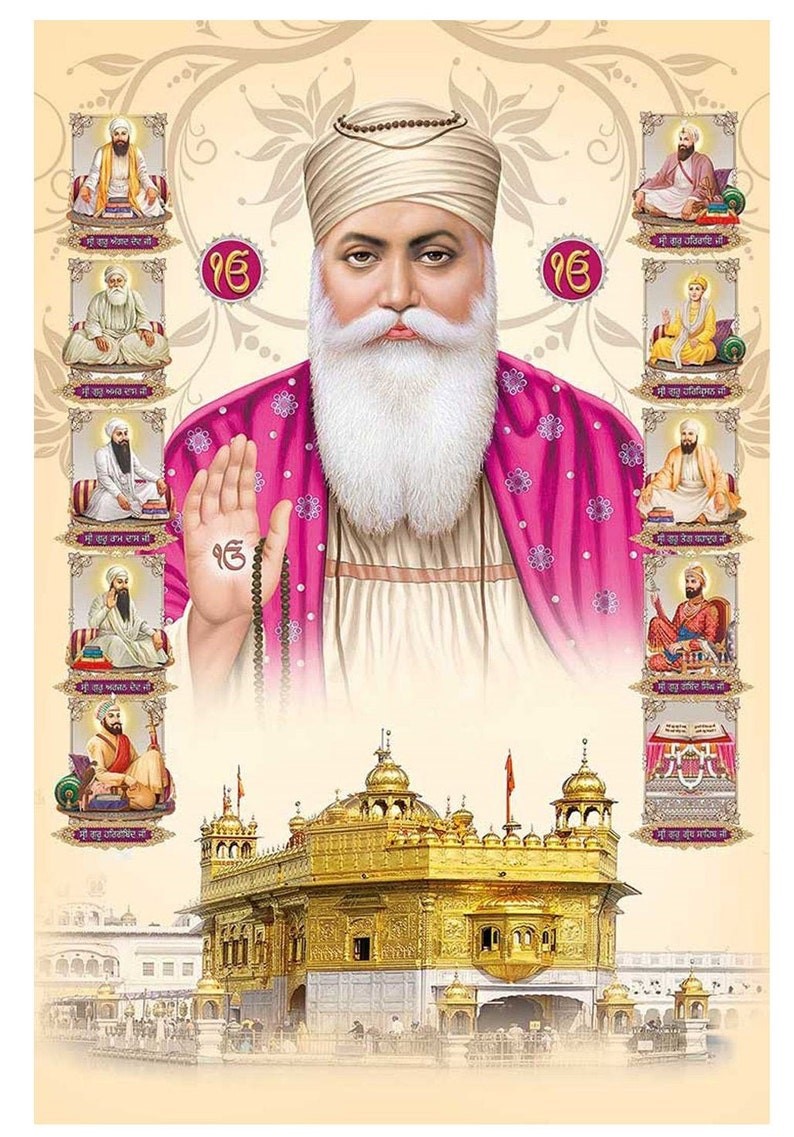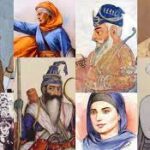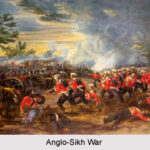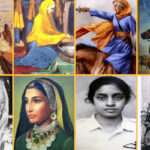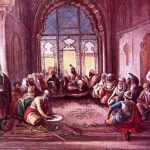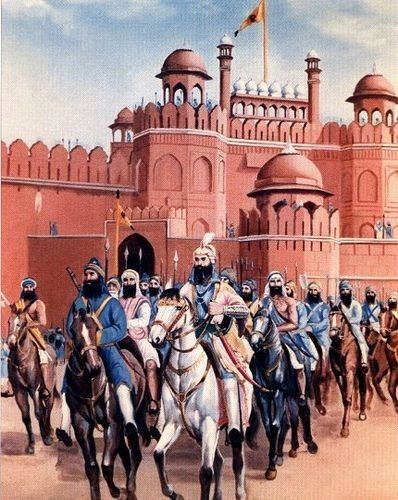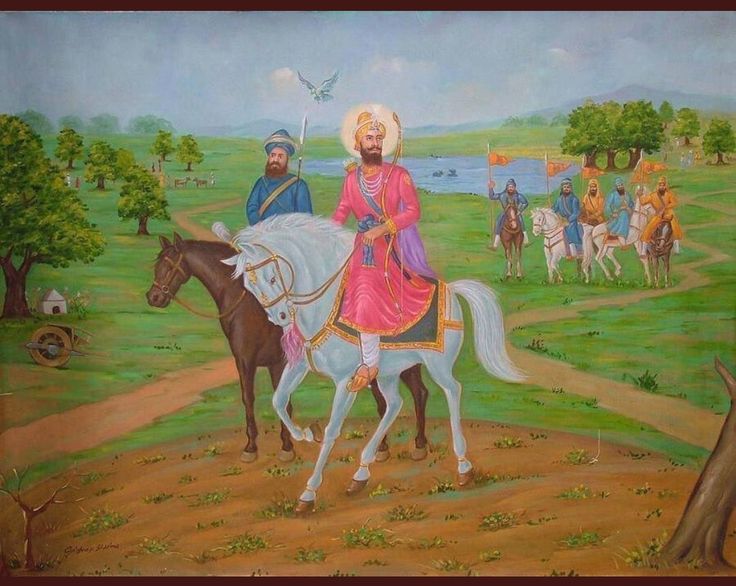From Guru Nanak Dev’s birth in 1469 to Guru Gobind Singh’s death, the reign of Sikhism’s 10 gurus covers nearly 300 years. Guru Gobind Singh bestowed his appellation of Guru to the Sikh text Guru Granth at the point of his death in 1708. Sikhs see Sikhism’s ten gurus as embodiments of a single beacon of light that has been handed down through the generations and is currently housed in the text Siri Guru Granth Sahib.
Sikhism, despite sharing some characteristics with each, is a distinct religion that worships a single god and considers that all civilizations worship him in their unique way. Let’s take a glance at how each Guru influenced Sikhism.
Guru Nanak (1469-1539)
Guru Nanak, the creator of Sikhism, was born into a Hindu household in a hamlet where Hindus and Muslims coexisted. Just at age of 13, the Guru turned down the sacred thread during his coming-of-age ritual. Years down the line, the Guru reappeared to his parents with a divine revelation following going missing for three days. Guru Nanak preached that there is only 1 god and that all civilizations, in some way, worship him. To know God, one must walk a road of honesty and diligence. The Guru was a vocal opponent of meaningless rituals and composed numerous lyrics and chants to instruct his disciples. He spent most of his life traveling across Asia and the Middle East to spread Sikhism.
Guru Angad (1539-1552)
Guru Angad, previously known as Lehna, got intensely committed to Guru Nanak and his lessons. Guru Nanak addressed him as Lehna and bestowed him the name Angad, which comes from the word and, which means hand. He then bestowed blessings on him and anointed him as his successor. The langar, a communal kitchen where anybody may congregate and eat, was one of Guru Angad’s most significant accomplishments, as was his ardent advocacy for kids’ education.
Guru Amar Das (1552-1574)
Guru Amar Das led a humble life dedicated to Sikh beliefs and community service. He enlarged the langar’s significance and established it in various locations, asking everyone who wanted to meet with him people first eat in the langar. He also preached that all individuals, including women, are equivalent in God’s eyes. He created a Sikh community that became Ramdaspur, which was eventually renamed Amritsar. Finally, he compiled all previous Gurus’ works, resulting in the first texts of the Sikh religious book, the Sri Guru Granth Sahib.
Guru Ram Das (1574-1581)
Guru Amar Das recommended his son-in-law Jetha for Guruship and named him Ram Das towards the end of his life. Guru Ram Das’ preaching upheld the impartiality idea. He also campaigned against superstitions and the slavish observance of rituals, food rules, and dress requirements. He advised Sikhs that sharing in the joys and sufferings of others was just as vital for spiritual progress as meditation.
Guru Arjan Dev Ji (1563 to 1606)
Guru Arjan was the 5th Sikh Guru and the very first Sikh martyr, having given his blood for the Sikhs. In Amritsar, the Guru build the groundwork for the Golden Temple (Harmandir Sahib). He also stated that every Sikh should give away a tenth of their income to a charitable organization. His highest praise to the Sikh faith was compiling all of the previous Gurus’ works within one book, the Guru Granth Sahib, which is now the sacred scripture. It was because of this sacred book that he became a martyr.
Guru Har Gobind Sahib Ji (1606 to 1644)
To protect the vulnerable and persecuted, Guru Hargobind Ji taught us it was indeed important to pick up the sword. Guruji was the first of the Gurus to safeguard the faith with arms. Only kings were permitted to sit on an elevated platform known as a that or crown at the time. Guru Hargobind constructed Sri Akal Takhat Sahib, ten feet above the earth, with two swords, Miri and Piri, symbolizing temporal and spiritual might, at the age of thirteen.
Guru Har Rai Sahib Ji (1644 to 1661)
Guru Har Rai was birthed around 1630 and devoted the majority of his life doing spiritual meditation and sharing Guru Nanak’s beliefs. Despite being a man of peace, Guru Har Rai Ji never dismissed the military Sikh Warriors who had previously been retained by his grandfather, Guru Hargobind. He consistently reinforced the Sikhs’ fighting spirit, although he never engaged in any direct political or military conflict with the Mughal Empire. He further carried on Guru Hargobind’s noble project of nation-building.
Guru Har Krishan Sahib Ji (1661 to 1664)
Guru Har Krishan was the Guru’s youngest son. Guru Ji astounded the Brahmin Pundits with his wisdom and mystical powers when he was established as Guru at the age of 5. He became an icon of compassion, honesty, and truth for the Sikhs. While serving and mending the epidemic-stricken inhabitants of Delhi, the Guru devoted his life.
Guru Tegh Bahadur Sahib Ji (1665 to 1675)
Guru Tegh Bahadur Sahib Ji created the town of Anandpur sahib. The Guru gave his life to defend Hinduism, their Tilak (devotional forehead marks), and their spiritual thread. He was a fervent believer in people’s right to freedom of religion. He was martyred for the sake of upholding the rights of the oppressed Hindus. A threatening forcible transformation of Kashmir’s Hindus was avoided due to his unwillingness to adapt to Islam.
Guru Gobind Singh Sahib Ji (1675 to 1708)
In 1699, Guru Gobind Singh Ji established the Khalsa, transforming the Sikhs into a saint-soldier order with distinctive emblems and sacraments for self-defense. He named the Sikhs Singh (lion) or Kaur (queen) (princess). He fought many battles versus Aurangzeb’s and his supporter’s army.
